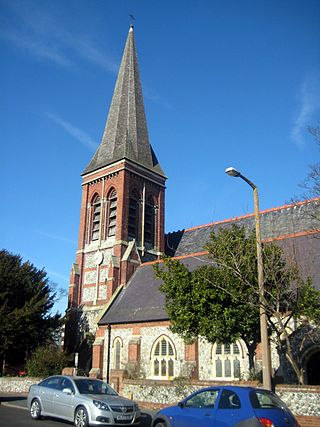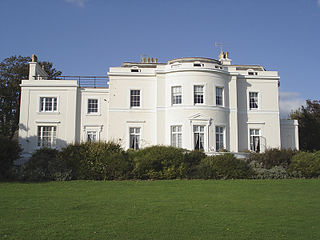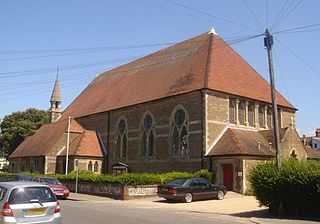
Worthing is a seaside town in West Sussex, England, at the foot of the South Downs, 10 miles (16 km) west of Brighton, and 18 miles (29 km) east of Chichester. With a population of 111,400 and an area of 12.5 square miles (32.4 km2), the borough is the second largest component of the Brighton and Hove built-up area, the 15th most populous urban area in the United Kingdom. Since 2010, northern parts of the borough, including the Worthing Downland Estate, have formed part of the South Downs National Park. In 2019, the Art Deco Worthing Pier was named the best in Britain.

Goring-by-Sea, commonly referred to simply as Goring, is a neighbourhood of Worthing and former civil parish, now in Worthing district in West Sussex, England. It lies west of West Worthing, about 2.5 miles (4 km) west of Worthing town centre. Historically in Sussex, in the rape of Arundel, Goring has been part of the borough of Worthing since 1929.

Durrington is a neighbourhood of Worthing and former civil parish, now in the borough of Worthing in West Sussex, England. Historically in Sussex, in the rape of Bramber, it is situated near the A27 road, 2.3 miles (3.7 km) northwest of the town centre. Since 1992 it has been home to the community-led Durrington Festival.

High Salvington is a neighbourhood of Worthing, in the borough of Worthing in West Sussex, England. It is centred 2.5 miles (4.0 km) northwest of the town centre and is north of the A27.

West Worthing is a neighbourhood of Worthing in West Sussex, England that was developed within Heene and later expanded beyond Heene's boundaries. Intended as an exclusive resort, the township of West Worthing was developed from around 1864 and merged with the formerly separate township of Worthing in 1890, when Worthing gained borough status.

Worthing Borough Council is a district council in the county of West Sussex, based in the borough of Worthing. The borough council was created in 1974 under the Local Government Act 1972 out of the existing Worthing Municipal Council, which also had borough status. It forms the lower tier of local government in Worthing, responsible for local services such as housing, planning, leisure and tourism. Since 2014 it has been a constituent council of the Greater Brighton City Region.

Worthing is a large seaside town in Sussex, England in the United Kingdom. The history of the area begins in Prehistoric times and the present importance of the town dates from the 19th century.
Worthing, a seaside town with borough status in the United Kingdom, is connected to the rest of the country by a network of major roads, a mainline railway, frequent bus and coach services and a nearby airport. Its 19th-century growth was encouraged by the development of turnpikes and stagecoach routes to London and nearby towns. By the middle of that century railway services improved journey times and conditions significantly. Suburbanisation in the 20th century was assisted by a network of bus routes.

Worthing, a town with borough status in the English county of West Sussex, has 212 buildings with listed status. The Borough of Worthing covers an area of 8,030 acres (3,250 ha) on the south coast of England, facing the English Channel. The town's development in the early 19th century coincided with nearby Brighton's rise as a famous, fashionable resort, and Worthing became a quiet seaside town with a large stock of Victorian buildings. Residential growth in the 20th century absorbed nearby villages, and older houses, churches and mansions became part of the borough. The Town and Country Planning Act 1947, an act of Parliament effective from 1948, introduced the concept of "listing" buildings of architectural and historical interest, and Worthing Borough Council nominated 90 buildings at that time. More have since been added, but others have been demolished. As of 2009, Worthing has three buildings of Grade I status, 11 listed at Grade II*, 196 of Grade II status and three at the equivalent Grade C.
The Teville Stream is a stream which flows through the town of Worthing in West Sussex. Once significantly wider than the current stream, it is now culverted for much of its length.

St George's Church is an Anglican church in the East Worthing area of the borough of Worthing, one of seven local government districts in the English county of West Sussex. Built in 1867–68 to serve new residential development in the southeast of the town, the Decorated Gothic-style structure was extended later in the 19th century, and expanded its reach further by founding three mission halls elsewhere in Worthing. English Heritage has listed it at Grade C for its architectural and historical importance.

Worthing, a seaside resort on the English Channel coast of West Sussex, southeast England, has a long maritime history predating its late 18th-century emergence as a fashionable holiday and residential town. Fishing was a major economic activity for centuries, and still retains a small presence on Worthing's shingle shoreline. Smuggling, usually by sea, also contributed to the growing town's economy. The formerly sandy beach has changed over time, partly because of sea defence work carried out to alleviate concerns over flooding, which has affected the town several times. Large seaweed deposits, driven up from the sea bed, have caused occasional problems, while undersea rock formations off the coast have national importance as a wildlife habitat. There have been many shipwrecks and groundings in the area, and lifeboats were stationed in the town for many years.

St Symphorian's Church is an Anglican church in the Durrington area of the borough of Worthing, one of seven local government districts in the English county of West Sussex. The original 13th-century chapelry declined and fell into ruins in the 17th century, partly due to damage caused by the English Civil War. Anglican worship was re-established in a tin tabernacle in 1890 as the former village grew into a suburb of Worthing, and during World War I a permanent church was built. It was extended during World War II. English Heritage has listed the building at Grade II for its architectural and historical importance.
A wide variety of sport in Worthing has been played, which has a long and interesting history.

Crawley, a postwar New Town and borough in the English county of West Sussex, has a wide range of public services funded by national government, West Sussex County Council, Crawley Borough Council and other public-sector bodies. Revenue to fund these services comes principally from Council Tax. Some of Crawley's utilities and infrastructure are provided by outside parties, such as utility companies and West Sussex County Council, rather than by the borough council. To help pay for improved infrastructure and service provision in proposed major residential developments such as Kilnwood Vale and the North East Sector, the borough council has stated that as part of the Crawley Local Plan it would require developers to pay a Community Infrastructure Levy.

The Worthing Downland Estate, Worthing Downs or Worthing Downland, is an area of land in the South Downs National Park in West Sussex, England, close to the town of Worthing. It was bought by the public, following threats to the beauty spot of Cissbury Ring and the surrounding farmland, which led to a public campaign purchases in the 1930s. It is currently owned and managed, on behalf of the public, by Worthing Borough Council.

East Worthing is a residential area of Worthing in the Worthing district, in the county of West Sussex, England, situated immediately to the east of Worthing town centre. It is bounded by the West Coastway railway line and Broadwater to the north, Brooklands Park to the east, Homefield Park and Worthing town centre to the west and the English Channel coast to the south.

The following is a timeline of the history of the borough of Worthing, West Sussex, England.

Brighton and Hove, a city and unitary authority in the English county of East Sussex, has a wide range of public services funded by national government, East Sussex County Council, Brighton and Hove City Council and other public-sector bodies. Revenue to fund these services comes partly from Council Tax, which is paid annually by residents: this tax provides the city council with nearly 20% of its income and also helps to fund the local police force, Sussex Police, and the county's fire service, East Sussex Fire and Rescue Service. Some of Brighton and Hove's utilities and infrastructure are provided by outside parties, such as utility companies, rather than by the city council.






















